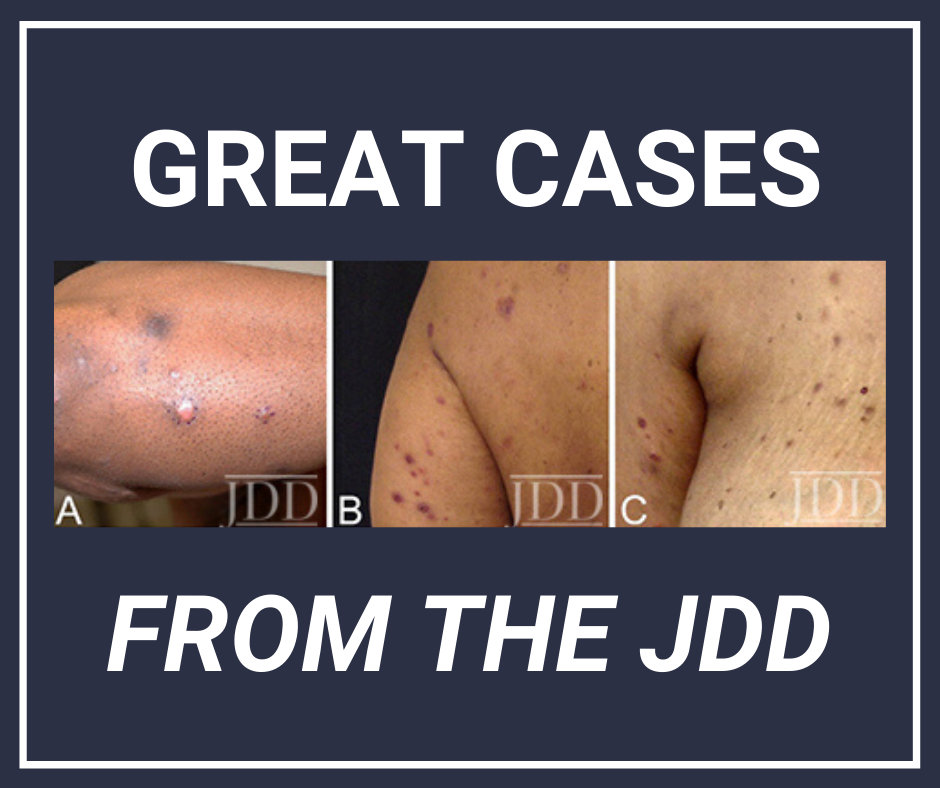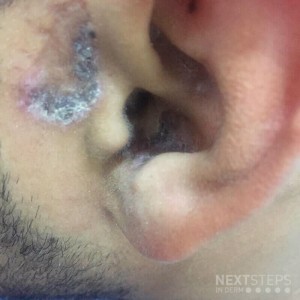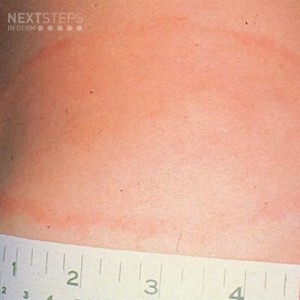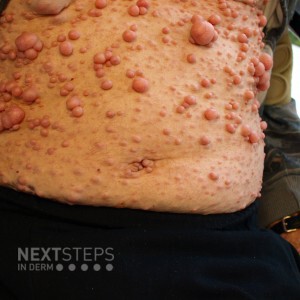Spindle Cells – Friday Pop Quiz 1/10
 Biopsy of one of the lesions pictured reveals spindle cells forming slit-like vascular channels. Which of the following is also associated with the cause of these lesions?
A. Bacillary angiomatosis
B. Merkel cell carcinoma
C. Angiosarcoma
D. Multicentric Castleman disease
E. Nasopharyngeal carcinoma
To find out the correct answer and read the explanation, click here.
Brought t …
Biopsy of one of the lesions pictured reveals spindle cells forming slit-like vascular channels. Which of the following is also associated with the cause of these lesions?
A. Bacillary angiomatosis
B. Merkel cell carcinoma
C. Angiosarcoma
D. Multicentric Castleman disease
E. Nasopharyngeal carcinoma
To find out the correct answer and read the explanation, click here.
Brought t …
 Biopsy of one of the lesions pictured reveals spindle cells forming slit-like vascular channels. Which of the following is also associated with the cause of these lesions?
A. Bacillary angiomatosis
B. Merkel cell carcinoma
C. Angiosarcoma
D. Multicentric Castleman disease
E. Nasopharyngeal carcinoma
To find out the correct answer and read the explanation, click here.
Brought t …
Biopsy of one of the lesions pictured reveals spindle cells forming slit-like vascular channels. Which of the following is also associated with the cause of these lesions?
A. Bacillary angiomatosis
B. Merkel cell carcinoma
C. Angiosarcoma
D. Multicentric Castleman disease
E. Nasopharyngeal carcinoma
To find out the correct answer and read the explanation, click here.
Brought t … 

 Lymphomatoid papulosis (LyP) is a CD30+ T-cell lymphoproliferative disorder (LPD) presenting as a recurrent eruption of papules and nodules which resolve spontaneously. CD30+ LPD prevalence in African American (AA)/Black patients is lower compared to White patients. CD30+ LPD has been recently reported to have worse outcomes in AA patients compared to White patients.
A retrospective chart revie …
Lymphomatoid papulosis (LyP) is a CD30+ T-cell lymphoproliferative disorder (LPD) presenting as a recurrent eruption of papules and nodules which resolve spontaneously. CD30+ LPD prevalence in African American (AA)/Black patients is lower compared to White patients. CD30+ LPD has been recently reported to have worse outcomes in AA patients compared to White patients.
A retrospective chart revie …  Which of the following is TRUE regarding this condition?
A. 50% of patients will eventually develop systemic involvement
B. C3 deficiency increases susceptibility to this condition
C. Biopsy typically shows a thinned basement membrane
D. Squamous cell carcinoma is a potential sequela
E. UV exposure is helpful in treatment
To find out the correct answer and read the explanation, …
Which of the following is TRUE regarding this condition?
A. 50% of patients will eventually develop systemic involvement
B. C3 deficiency increases susceptibility to this condition
C. Biopsy typically shows a thinned basement membrane
D. Squamous cell carcinoma is a potential sequela
E. UV exposure is helpful in treatment
To find out the correct answer and read the explanation, …  A 27 year-old woman who is 30 weeks pregnant presents with erythema migrans. The treatment of choice for this patient is:
A. Doxycycline
B. Erythromycin
C. Chloramphenicol
D. Clindamycin
E. Amoxicillin
To find out the correct answer and read the explanation, click here.
Brought to you by our brand partner Derm In-Review. A product of SanovaWorks.
…
A 27 year-old woman who is 30 weeks pregnant presents with erythema migrans. The treatment of choice for this patient is:
A. Doxycycline
B. Erythromycin
C. Chloramphenicol
D. Clindamycin
E. Amoxicillin
To find out the correct answer and read the explanation, click here.
Brought to you by our brand partner Derm In-Review. A product of SanovaWorks.
…  This condition has which type of inheritance pattern?
A. Autosomal recessive
B. Autosomal dominant
C. X-linked recessive
D. X-linked dominant
E. Sporadic
To find out the correct answer and read the explanation, click here.
Brought to you by our brand partner Derm In-Review. A product of SanovaWorks.
…
This condition has which type of inheritance pattern?
A. Autosomal recessive
B. Autosomal dominant
C. X-linked recessive
D. X-linked dominant
E. Sporadic
To find out the correct answer and read the explanation, click here.
Brought to you by our brand partner Derm In-Review. A product of SanovaWorks.
…